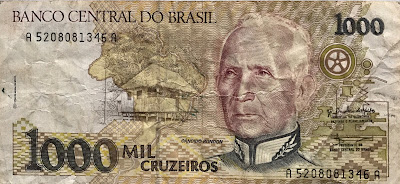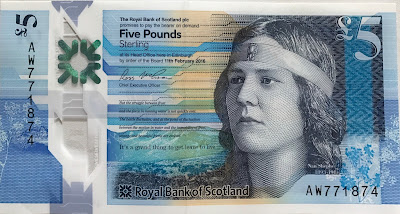Monday 17 April 2017
Brazil Banknote - Brazil 1000 Cruzeiros banknote 1991 Candido Rondon
Obverse: Portrait of Candido Mariano da Silva Rondon, or Marechal Rondon (1865 – 1958) was a Brazilian military officer who is most famous for his exploration of Mato Grosso and the Western Amazon Basin. Map outline of Brazil and hut in Amazon jungle - Old Telegraph Station (In 1890, Candido Rondon was commissioned as an army engineer with the Telegraphic commission, and helped build the first telegraph line across the state of Mato Grosso.)
Reverse: Brazilian Girls (Native Brazilians - Carajás Indians from the Araguaya River). Local food from Amazonia: fish, maize, vegetables and pineapples. Watermark: The Effigy of the Republic of Brazil (Portuguese: Efígie da República) is used as a national personification, both in Brazil and in Portugal, symbolizing the Republic.
Tuesday 4 April 2017
Royal Bank of Scotland £5 note
The Royal Bank of Scotland £5 note, also known as a fiver, is a banknote of the pound sterling. It is the second smallest denomination of banknote issued by The Royal Bank of Scotland. The current polymer note, first issued in 2016, bears an image of the author Nan Shepherd on the obverse and a pair of mackerel on the reverse. Source
The Royal Bank of Scotland began issuing £5 notes in 1727, the same year as the bank's founding.Though strictly not legal tender in Scotland, Scottish banknotes are nevertheless legal currency and are generally accepted throughout the United Kingdom.
5 Pound Banknote
Thanks to Agnes for the note!
Scotland's Clydesdale Bank £5 note
The Clydesdale Bank £5 note is a banknote of the pound sterling. It is the smallest denomination of banknote issued by the Clydesdale Bank. The current polymer note, first issued in 2015, bears an image of engineer William Arrol on the obverse and an image of the Forth Bridge on the reverse. It is the first fully polymer banknote to go into circulation in the United Kingdom. Source
The Clydesdale Bank began issuing £5 notes in 1838, the same year as the bank's founding.Though strictly not legal tender in Scotland, Scottish banknotes are nevertheless legal currency and are generally accepted throughout the United Kingdom.
5 Pound Banknote
Thanks to Agnes for the bill!
Subscribe to:
Posts (Atom)





